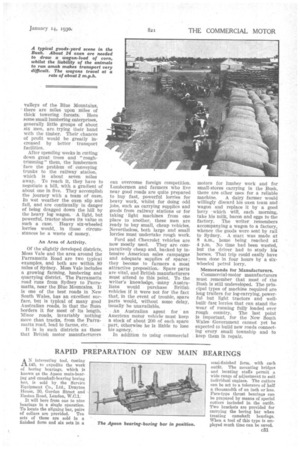The Transport Needs
Page 52

Page 53

If you've noticed an error in this article please click here to report it so we can fix it.
of the
Australian Bushman
—Well-built Light Lorries, Light Powerful Tractors, Fast Heavy Vehicles and Larg-e Trailers
'VEN to-day many
4 I persons still believe the Australian Bush to be a jungle where sly dingos, wild-cats, spiteful grey bears, kangaroos and poisonous snakes are a constant danger to settlers. Others think that the New South Wales Government has " civilized " the Bush and has made fine roads connecting the numerous townships that are springing up everywhere. Both conceptions are partly right. There are great districts still infested with snakes and wild animals, where deep-rutted cart tracks, which are used by solitary settlers, form the only means for communication. Again, there are good roads in recently developed districts.
Uncultivated Areas.
First, take two instances of rough transport. The land near Wyong and Bundanoon is typically representative of the great area of undeveloped Bush. Both place st are situated about 100 miles from Sydney. On the outskirts of Wyong a wide river flows c30 into Tuggorah Lake about two miles away. Five miles from the town, on the river banks, is a number of fishermen's and lumbermen's shacks. To cross to the opposite bank, carts must be poled over on a clumsy raft, whilst pedestrians use a small punt. Once across, a drive or walk along a single track leads to home or hut. The track ruts may be 1 ft. or more deep and, in rainy weather, the river wally overflows and holds up horsed traffic.
Light Lorries Useful.
This is where a strong, but light, lorry would be appreciated. For settlers to reach the town, during the period of flood, is almost impossible. Horses will not face the danger of liver snakes on the rough track, and very few persons own launches that will face the current. Therefore, in the absence of suitable mechanical transport, settlers must perforce await the subsiding of the waters.
Near Bundanoon the country is very hilly. In one of the many valleys of the Blue Mountains, there are miles upon miles of thick towering forests. Here some small lumbering enterprises, generally little groups of about six men, are trying their hand with the timber. Their chances of profit would be greatly increased by better transport facilities.
After spending weeks in cutting down great trees and "roughtrimming" them, the lumbermen face the problem of conveying trunks to the railway station, which is about seven miles away. To reach it, they have to negotiate a bill, with a gradient of about one in five. They accomplish the journey with a team of oxen. In wet weather the oxen slip and fall, and are continually in danger of being dragged down the hill by the heavy log wagon. A light, but powerful, tractor shows its value in such a case. Heavy six-wheeled lorries would,. in those circumstances be a waste of money.
An Area of Activity.
Of the slightly developed districts, Moss Vale and the area around the Parramatta Road are two typical examples, and both are within 80 miles of Sydney. Moss Vale includes a growing farming, lumbering and quarrying district. The Parramatta road runs from Sydney to Parramatta, near the Blue Mountains. It is one of the best roads in New South Wales, has an excellent surface, but is typical of many good Australian roads, in that the Rift borders it for most ofits length. Minor roads, invariably nothing more than tracks, from the Parra
matta road, lead to farms, etc. .= It is in such districts as these that British motor manufacturers can overcome foreign competition. Lumbermen and farmers who live near good roads are quite prepared to buy fast, powerful lorries for heavy work, whilst for doing odd jobs, such as carrying supplies and goods from railway stations or for taking light machines from one place to another, these men are ready to buy small, cheap vehicles. Nevertheless, both large and small lorries must undertake rough work.
Pord and Chevrolet vehicles are now mostly used. They are comparatively cheap and, backed by intensive American sales campaigns and adequate supplies of spares ; they become to farmers a most attractive proposition.. Spare parts are vital, and British manufacturers must attend to this point. To the writer's knowledge, -many Australians would purchase British vehicles if it were not for the fact that, in the event of trouble, spare parts would, without some delay, usually be unavailable.
An Australian agent for an American motor vehicle must keep a stock of about 200 of each spare part, Otherwise he is liable to lose his agency.
In addition to using commercial motors for lumber work and for small-stores carrying in the Bush, there are other uses for a reliable machine. A dairy farmer would willingly discard his oxen team and wagon and replace it by a good lorry which will, each morning, ' take his milk, bacon and eggs to the factory. The writer remembers accompanying a wagon to a factory, whence the goods were sent by rail to Sydney. A start was made at 8 a.m., home being, reached at 4 p.m. No time had been wasted, but the driver had to study his horses. That trip could easily have been done in four hours by a sixwheeled petrol lorry.
Memoranda for Manufacturers.
Commercial-motor manufacturers must remember that most of the Bush is still undeveloped. The principal types of machine required are long trailers for log-carrying, powerful but light tractors and wellbuilt •fast lorries that can stand the wear of running fully loaded over rough country. The last point is important, for the New South Wales 'Government cannot yet be expected to build new roads connecting every small township and to keep them in repair.












































































































